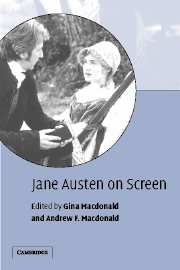Book contents
- Frontmatter
- Contents
- List of illustrations
- List of contributors
- Acknowledgments
- Introduction
- 1 Short “Takes” on Austen: summarizing the controversy between literary purists and film enthusiasts
- 2 Janeite culture: what does the name “Jane Austen” authorize?
- 3 “Such a transformation!”: translation, imitation, and intertextuality in Jane Austen on screen
- 4 Two Mansfield Parks: purist and postmodern
- 5 Sense and Sensibility in a postfeminist world: sisterhood is still powerful
- 6 Regency romance shadowing in the visual motifs of Roger Michell's Persuasion
- 7 Filming romance: Persuasion
- 8 Emma, interrupted: speaking Jane Austen in fiction and film
- 9 Reimagining Jane Austen: the 1940 and 1995 film versions of Pride and Prejudice
- 10 Emma and the art of adaptation
- 11 Clues for the clueless
- Questions for discussion
- Filmography
- Bibliography
- Index
6 - Regency romance shadowing in the visual motifs of Roger Michell's Persuasion
Published online by Cambridge University Press: 05 June 2012
- Frontmatter
- Contents
- List of illustrations
- List of contributors
- Acknowledgments
- Introduction
- 1 Short “Takes” on Austen: summarizing the controversy between literary purists and film enthusiasts
- 2 Janeite culture: what does the name “Jane Austen” authorize?
- 3 “Such a transformation!”: translation, imitation, and intertextuality in Jane Austen on screen
- 4 Two Mansfield Parks: purist and postmodern
- 5 Sense and Sensibility in a postfeminist world: sisterhood is still powerful
- 6 Regency romance shadowing in the visual motifs of Roger Michell's Persuasion
- 7 Filming romance: Persuasion
- 8 Emma, interrupted: speaking Jane Austen in fiction and film
- 9 Reimagining Jane Austen: the 1940 and 1995 film versions of Pride and Prejudice
- 10 Emma and the art of adaptation
- 11 Clues for the clueless
- Questions for discussion
- Filmography
- Bibliography
- Index
Summary
Commentators on Roger Michell's 1995 film adaptation of Persuasion have criticized the incongruity of Captain Wentworth and Ann Elliot embracing in the street and the marketing strategy that placed on the cover of the video-cassette a “still” of a torrid embrace that never occurred in the film. Inevitably, recreation and “purity” of text becomes tangled with questions of “purity” of motivation: can productions based on the profit motive do justice to the aesthetic value of a literary text or do they reshape and distort the text to appeal to the values, prejudices, and expectations of the mass audience? Some commentators answer no to the first question and bewail the manipulations referred to in the second. For example, Amanda Collins laments the nostalgic propensity of recent Austen adaptations to rewrite history as a reflection of the present and of the present's distorted view of the past.
Yet, twentieth-century filmmakers standing at a historical and cultural distance from Austen's world must translate Austen's intent into filmic representations that carry significance for modern filmgoers. As Harriet Margolis suggests in Chapter 2 of this text, Coleridge's distinction between faithful copies and imaginative imitations of literary masterworks is most pertinent to this debate about the value of recent Austen adaptations. No matter how well-crafted and entertaining a near-as-possible duplication is, a “purist” copy that seeks total fidelity to text will never be faithful enough simply because of the difference between written art and filmic art.
- Type
- Chapter
- Information
- Jane Austen on Screen , pp. 111 - 126Publisher: Cambridge University PressPrint publication year: 2003
- 1
- Cited by

